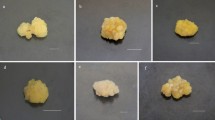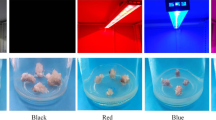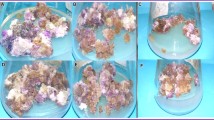Abstract
In Camellia japonica callus culture, the effects of light quality on the accumulation of phenolic compounds were examined. To this end, the calli were cultured under three monochrome [white (W), red (R), and blue (B)] and two mixed [red/blue (RB) and red/green/blue (RGB)] light sources. After 4 weeks of culture, fresh and dry callus weights were determined, and phenolic content was analyzed using high-performance liquid chromatography. We also examined the effects of RGB light on calli derived from four origins (leaf: CL; root: CR; petal: CP; and ovary: CO). Total phenolic and flavonoid content and DPPH radical scavenging activity were highest in calli exposed to RB and RGB. Catechin was detected only in calli exposed to mixed light (RB and RGB). Interestingly, red pigmentation development in CL and CR calli after 2 weeks of culture and organogenic calli in CR and CP samples was observed. Furthermore, expression of the phenylalanine ammonia lyase and chalcone synthase genes was found to be higher in the CR line than in other lines, and total phenolic and flavonoid content was also higher in the CR and CP lines. The findings of the present study revealed that the accumulation of phenolics and flavonoids in callus tissue varies depending on light quality, which stimulates cell division, and may thus affect the proliferation and organogenesis of C. japonica callus. We also established that the effects of light on red pigment expression and the accumulation of bioactive compounds are dependent on the tissue origin of callus material.








Similar content being viewed by others
References
Ahmad N, Rab A, Ahmad N (2016) Light-induced biochemical variations in secondary metabolite production and antioxidant activity in callus cultures of Stevia rebaudiana (Bert). J Photochem Photobiol B 154:51–56
Ahn SY, Kim SA, Choi SJ, Yun HK (2015) Comparison of accumulation of stilbene compounds and stilbene related gene expression in two grape berries irradiated with different light sources. Hortic Environ Biotechnol 56:36–43
Anjum S, Abbasi BH, Hano C (2017) Trends in accumulation of pharmacologically important antioxidant-secondary metabolites in callus cultures of Linum usitatissimum L. Plant Cell Tissue Organ Cult 129:73–87
Barciela J, Vieitez AM (1993) Anatomical sequence and morphometric analysis during somatic embryogenesis on cultured cotyledon explants of Camellia japonica L. Ann Bot 71:395–404
Batista DS, Felipe SH, Silva T, de Castro KM, Mamedes-Rodrigues TC, Miranda NA, Torres-Silva G (2018) Light quality in plant tissue culture: does it matter? In Vitro Cell Dev Biol Plant 54:195–215
Batschauer A, Rocholl M, Kaiser T, Nagatani A, Furuya M, Schäfer E (1996) Blue and UV-A light-regulated CHS expression in Arabidopsis independent of phytochrome a and phytochrome B. Plant J 9:63–69
Bello-Bello JJ, Martínez-Estrada E, Caamal-Velázquez JH, Morales-Ramos V (2016) Effect of LED light quality on in vitro shoot proliferation and growth of vanilla (Vanilla planifolia Andrews). Afr J Biotechnol 15:272–277
Bordage S, Sullivan S, Laird J, Millar AJ, Nimmo HG (2016) Organ specificity in the plant circadian system is explained by different light inputs to the shoot and root clocks. New Phytol 212:136–149
Carvalho SD, Schwieterman ML, Abrahan CE, Colquhoun TA, Folta KM (2016) Light quality dependent changes in morphology, antioxidant capacity, and volatile production in sweet basil (Ocimum basilicum). Front Plant Sci 7:1328
Chen QR, Li D, Qin XJ, Liu H, Ni W, Yan H, Liu HY (2018) Bioactive triterpenoid glycosides from the twigs and leaves of Camellia reticulata. Phytochem Lett 25:6–11
Darko E, Heydarizadeh P, Schoefs B, Sabzalian MR (2014) Photosynthesis under artificial light: the shift in primary and secondary metabolism. Philos Trans R Soc B 369:1640
Daud N, Faizal A, Geelen D (2013) Adventitious rooting of Jatropha curcas L. is stimulated by phloroglucinol and by red LED light. In Vitro Cell Dev Biol Plant 49:183–190
Fazal H, Abbasi BH, Ahmad N, Ali SS, Akbar F, Kanwal F (2016) Correlation of different spectral lights with biomass accumulation and production of antioxidant secondary metabolites in callus cultures of medicinally important Prunella vulgaris L. J Photochem Photobiol B 159:1–7
Feinbaum RL, Storz G, Ausbel FM (1991) High intensity and blue light regulated expression of chimeric chalcone synthase genes in transgenic Arabidopsis thaliana plants. Mol Gen Genet 226:449–456
Folin O, Ciocalteu V (1927) On trysonic and tryptophane determination in protein. J Biol Chem 27:627–650
Fukuda N, Fujita M, Ohta Y, Sase S, Nishimura S, Ezura H (2008) Directional blue light irradiation triggers epidermal cell elongation of abaxial side resulting in inhibition of leaf epinasty in geranium under red light condition. Sci Hortic 115:176–182
Hatano T, Kagawa H, Yasuhara T, Okuda T (1998) Two new flavonoids and other constituents in licorice: their relative astringency and radical scavenging effects. Chem Pharm Bull 36:2090–2097
Ji XH, Wang YT, Zhang R, Wu SJ, An MM, Li M, Wang CZ, Chen XL, Zhang YM, Chen XS (2015) Effect of auxin, cytokinin and nitrogen on anthocyanin biosynthesis in callus cultures of red-fleshed apple (Malus sieversii f. niedzwetzkyana). Plant Cell Tissue Organ Cult 120:325–337
Jiang X, Liu Y, Li W, Zhao L, Meng F, Wang Y, Gao L (2013) Tissue-specific, development-dependent phenolic compounds accumulation profile and gene expression pattern in tea plant [Camellia sinensis]. PLoS One 8:e62315
Johkan M, Shoji K, Goto F, Hashida SN, Yoshihara T (2010) Blue light-emitting diode light irradiation of seedlings improves seedling quality and growth after transplanting in red leaf lettuce. HortScience 45:1809–1814
Jung SK, Lee KW, Kim HY, Oh MH, Byun S, Lim SH, Lee HJ (2010) Myricetin suppresses UVB-induced wrinkle formation and MMP-9 expression by inhibiting Raf. Biochem Pharmacol 79:1455–1461
Kadomura-Ishikawa Y, Miyawaki K, Noji S, Takahashi A (2013) Phototropin 2 is involved in blue light-induced anthocyanin accumulation in Fragaria x ananassa fruits. J Plant Res 126:847–857
Karuppusamy S (2009) A review on trends in production of secondary metabolites from higher plants by in vitro tissue, organ and cell cultures. J Med Plant Res 3:1222–1239
Kwon AR, Cui HY, Lee H, Shin H, Kang KS, Park SY (2015) Light quality affects shoot regeneration, cell division, and wood formation in elite clones of Populus euramericana. Acta Physiol Plant 37:65
Lee HH, Paudel KR, Jeong J, Wi AJ, Park WS, Kim DW, Oak MH (2016) Antiatherogenic effect of Camellia japonica fruit extract in high fat diet-fed rats. Evid Based Complement Alternat Med 2016:9679867
Li Q, Kubota C (2009) Effects of supplemental light quality on growth and phytochemicals of baby leaf lettuce. Environ Exp Bot 67:59–64
Li Q, Lei S, Du K, Li L, Pang X, Wang Z, Xu L (2016) RNA-seq based transcriptomic analysis uncovers α-linolenic acid and jasmonic acid biosynthesis pathways respond to cold acclimation in Camellia japonica. Sci Rep 6:36463
Llorente B, Martinez-Garcia JF, Stange C, Rodriguez-Concepcion M (2017) Illuminating colors: regulation of carotenoid biosynthesis and accumulation by light. Curr Opin Plant Biol 37:49–55
Lobiuc A, Vasilache V, Oroian M, Stoleru T, Burducea M, Pintilie O, Zamfirache MM (2017) Blue and red LED illumination improves growth and bioactive compounds contents in acyanic and cyanic Ocimum basilicum L. Microgreens. Molecules 22:2111
López-Laredo AR, Ramírez-Flores FD, Sepúlveda-Jiménez G, Trejo-Tapia G (2009) Comparison of metabolite levels in callus of Tecoma stans (L.) Juss. Ex Kunth. Cultured in photoperiod and darkness. In Vitro Cell Dev Biol Plant 45:550–558
Maharik N, Elgengaihi S, Taha H (2009) Anthocyanin production in callus cultures of Crataegus sinaica Boiss. Int J Acad 1:30–34
Manivannan A, Soundararajan P, Halimah N, Ko CH, Jeong BR (2015) Blue LED light enhances growth, phytochemical contents, and antioxidant enzyme activities of Rehmannia glutinosa cultured in vitro. Hortic Environ Biotechnol 56:105–113
Miao L, Zhang Y, Yang X, Xiao J, Zhang H, Zhang Z, Jiang G (2016) Colored light-quality selective plastic films affect anthocyanin content, enzyme activities, and the expression of flavonoid genes in strawberry (Fragaria× ananassa) fruit. Food Chem 207:93–100
Murasnige T, Skoog M (1962) A revised medium for rapid growth and bioassays with tobacco tissue cultures. Physiol Plant 15:473–497
Osakabe Y, Miyata S, Urao T, Seki M, Shinozaki K, Yamaguchi-Shinozaki K (2002) Overexpression of Arabidopsis response regulators, ARR4/ATRR1/IBC7 and ARR8/ATRR3, alters cytokinin responses differentially in the shoot and in callus formation. Biochem Biophys Res Commun 293:806–815
Páscoa RN, Teixeira AM, Sousa C (2019) Antioxidant capacity of Camellia japonica cultivars assessed by near-and mid-infrared spectroscopy. Planta 249:1053–1062
Pedroso RCN, Branquinho NAA, Hara AC, Costa AC, Silva FG, Pimenta LP, Januario AH (2017) Impact of light quality on flavonoid production and growth of Hyptis marrubioides seedlings cultivated in vitro. Rev Bras 27:466–470
Piovan A, Caniato R, Cappelletti EM, Filippini R (2010) Organogenesis from shoot segments and via callus of endangered Kosteletzkya pentacarpos (L.) Ledeb. Plant Cell Tissue Organ Cult 100:309–315
Qian H, Liu T, Deng M, Miao H, Cai C, Shen W, Wang Q (2016) Effects of light quality on main health-promoting compounds and antioxidant capacity of Chinese kale sprouts. Food Chem 196:1232–1238
Riefler M, Novak O, Strnad M, Schmülling T (2006) Arabidopsis cytokinin receptor mutants reveal functions in shoot growth, leaf senescence, seed size, germination, root development, and cytokinin metabolism. Plant Cell 18:40–54
Rodríguez López CM, Wetten AC, Wilkinson MJ (2010) Progressive erosion of genetic and epigenetic variation in callus-derived cocoa (Theobroma cacao) plants. New Phytol 186:856–868
Shetty R, Fretté X, Jensen B, Shetty NP, Jensen JD, Jørgensen HJL, Christensen LP (2011) Silicon-induced changes in antifungal phenolic acids, flavonoids and key phenylpropanoid pathway genes during the interaction between miniature roses and the biotrophic pathogen Podosphaera pannosa. Plant Physiol 157:111
Shohael AM, Ali MB, Yu KW, Hahn EJ, Islam R, Paek KY (2006) Effect of light on oxidative stress, secondary metabolites and induction of antioxidant enzymes in Eleutherococcus senticosus somatic embryos in bioreactor. Process Biochem 41:1179–1185
Sivakumar G, Heo JW, Kozai T, Peak KY (2006) Effect of continuous or intermittent radiation on sweet potato plantlets in vitro. J Hortic Sci Biotechnol 81:546–548
Slatnar A, Mikulic Petkovsek M, Halbwirth H, Stampar F, Stich K, Veberic R (2010) Enzyme activity of the phenylpropanoid pathway as a response to apple scab infection. Ann Appl Biol 156:449–456
Thain SC, Murtas G, Lynn JR, McGrath RB, Millar AJ (2002) The circadian clock that controls gene expression in Arabidopsis is tissue specific. Plant Physiol 130:102–110
To JP, Haberer G, Ferreira FJ, Deruere J, Mason MG, Schaller GE, Alonso JM, Ecker JP, Kieber JJ (2004) Type-A Arabidopsis response regulators are partially redundant negative regulators of cytokinin signaling. Plant Cell 16:658–671
Vieitez AM, Barciela J (1990) Somatic embryogenesis and plant regeneration from embryonic tissues of Camellia japonica L. Plant Cell Tissue Organ Cult 21:267–274
Vieitez AM, Carmen San-Jose M, Ballester A (1989) Progress towards clonal propagation of Camellia japonica cv. Alba Plena by tissue culture techniques. J Hortic Sci 64:605–610
Wang H, Jiang YP, Yu HJ, Xia XJ, Shi K, Zhou YH, Yu JQ (2010) Light quality affects incidence of powdery mildew, expression of defence-related genes and associated metabolism in cucumber plants. Eur J Plant Pathol 127:125–135
Wang QM, Wang L (2012) An evolutionary view of plant tissue culture: somaclonal variation and selection. Plant Cell Rep 31:1535–1547
Wang YS, Gao LP, Wang ZR, Liu YJ, Sun ML, Yang DQ, Wei CL, Shan Y, Xia T (2012) Light-induced expression of genes involved in phenylpropanoid biosynthetic pathways in callus of tea (Camellia sinensis (L.) O. Kuntze). Sci Hortic 133:72–83
Wijesekara I, Zhang C, Van Ta Q, Vo TS, Li YX, Kim SK (2014) Physcion from marine-derived fungus Microsporum sp. induces apoptosis in human cervical carcinoma HeLa cells. Microbiol Res 169:255–261
Wu CH, Dewir YH, Hahn EJ, Paek KY (2006) Optimization of culturing conditions for the production of biomass and phenolics from adventitious roots of Echinacea angustifolia. J Plant Biol 49:193–199
Wu MC, Hou CY, Jiang CM, Wang YT, Wang CY, Chen HH, Chang HM (2007) A novel approach of LED light radiation improves the antioxidant activity of pea seedlings. Food Chem 101:1753–1758
Xu F, Cao S, Shi L, Chen W, Su X, Yang Z (2014) Blue light irradiation affects anthocyanin content and enzyme activities involved in postharvest strawberry fruit. J Agric Food Chem 62:4778–4783
Yu W, Liu Y, Song L, Jacobs DF, Du X, Ying Y, Wu J (2017) Effect of differential light quality on morphology, photosynthesis, and antioxidant enzyme activity in Camptotheca acuminata seedlings. J Plant Growth Regul 36:148–160
Yue W, Ming QL, Lin B, Rahman K, Zheng CJ, Han T, Qin LP (2016) Medicinal plant cell suspension cultures: pharmaceutical applications and high-yielding strategies for the desired secondary metabolites. Crit Rev Biotechnol 36:215–232
Zagoskina NV, Dubravina GA, Alyavina AK, Goncharuk EA (2003) Effect of ultraviolet (UV-B) radiation on the formation and localization of phenolic compounds in tea plant callus cultures. Russ J Plant Physiol 50:270–275
Zagoskina NV, Alyavina AK, Gladyshko TO, Lapshin PV, Egorova EA, Bukhov NG (2005) Ultraviolet rays promote development of photosystem II photochemical activity and accumulation of phenolic compounds in the tea callus culture (Camellia sinensis). Russ J Plant Physiol 52:731–739
Zoratti L, Karppinen K, Luengo Escobar A, Häggman H, Jaakola L (2014) Light-controlled flavonoid biosynthesis in fruits. Front Plant Sci 5:53
Funding
This work was supported by the Korean Institute of Planning and Evaluation for Technology in Food, Agriculture, Forestry and Fisheries (IPET) through the Advanced Production Technology Development Program, funded by the Ministry of Agriculture, Food and Rural Affairs (MAFRA) (grant number 315013-4), and the authors were partially supported by BK 21 of Chungbuk National University.
Author information
Authors and Affiliations
Contributions
EB Jang contributed to the data acquisition and wrote the manuscript. TT Ho participated in the experiment and sample analysis. S-Y Park made substantial contributions to data interpretation, revising of the manuscript, the conception, and design of the study.
Corresponding author
Ethics declarations
Conflict of Interest
The authors declare that they have no conflict of interest.
Additional information
Editor: Yong Eui Choi
Rights and permissions
About this article
Cite this article
Jang, E.B., Ho, TT. & Park, SY. Effect of light quality and tissue origin on phenolic compound accumulation and antioxidant activity in Camellia japonica calli. In Vitro Cell.Dev.Biol.-Plant 56, 567–577 (2020). https://doi.org/10.1007/s11627-020-10121-9
Received:
Accepted:
Published:
Issue Date:
DOI: https://doi.org/10.1007/s11627-020-10121-9




